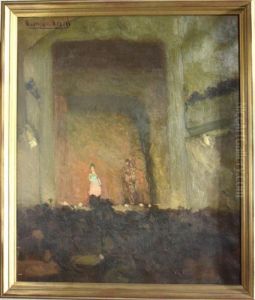Ricard Urgell Paintings
Ricard Urgell was a prominent figure in the Catalan art scene during the late 19th and early 20th centuries, though the precise details of his birth and death years may vary according to different sources. His artistic journey is often celebrated for its versatility and depth, encompassing a broad range of subjects and styles that reflected the turbulent and transformative times in which he lived. Urgell's work is deeply rooted in the traditions of Catalan modernism, yet it also exhibits a distinctive personal style that sets it apart from his contemporaries.
Urgell's early years were marked by a vigorous engagement with the artistic milieu of Barcelona, a city that was a vibrant center for cultural and artistic innovation during his lifetime. He received his initial training in art at the prestigious Llotja School, where many Catalan artists of the era began their formal education. This foundational period was essential in shaping Urgell's artistic vision, which would evolve to embrace both the traditional and the avant-garde.
Throughout his career, Ricard Urgell distinguished himself as a master of landscape and marine painting, genres that he elevated with his unique approach to light, color, and composition. His landscapes, often characterized by a serene, almost mystical quality, capture the essence of the Catalan countryside and the Mediterranean coast. These works not only reflect his profound connection to the natural world but also exhibit his extraordinary ability to convey mood and atmosphere.
In addition to his achievements in painting, Urgell was an active participant in the cultural life of Barcelona, contributing to the artistic and intellectual discourse of his time. He was involved with several artistic societies and participated in numerous exhibitions, both in Spain and abroad, gaining recognition and accolades for his work. Urgell's legacy is that of an artist who bridged the gap between tradition and innovation, creating a body of work that remains influential in the context of Catalan and Spanish art history.
Despite his contributions to the art world, Ricard Urgell's name may not be as widely recognized today as some of his contemporaries. However, his work continues to be appreciated by art historians and collectors who acknowledge his role in the development of modern Catalan art. His paintings are held in several prestigious collections and museums, serving as a testament to the enduring appeal and significance of his artistic vision.
